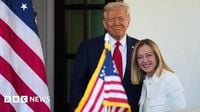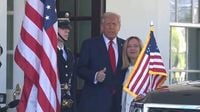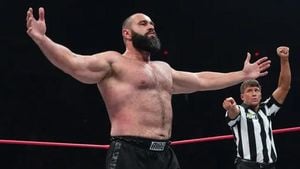On Thursday, April 17, 2025, President Donald Trump welcomed Italian Prime Minister Giorgia Meloni to the White House, marking her as the first European leader to engage in face-to-face talks with him since he announced and then partially suspended a 20% tariff on European exports. This meeting comes amid ongoing negotiations regarding trade agreements that have strained relations between the U.S. and the European Union.
During the meeting, Trump expressed optimism about reaching a trade deal with the EU, stating, "There’ll be a trade deal," while emphasizing that he is in no rush to finalize any agreements. He added, "I fully expect it, but it’ll be a fair deal," without providing a specific timeline for when he expected these deals to be finalized. The president’s remarks suggest a willingness to negotiate, but he also insisted that other nations would need to make concessions to avoid high tariffs.
Meloni, who has been described as a close ideological ally of Trump, aims to strengthen her leadership by positioning herself as a mediator between the EU and the U.S. She remarked, "I’m sure we can make a deal, and I’m here to help on that," while also highlighting the necessity for Trump to engage with other European leaders, stating, "I cannot do this deal in the name of the European Union." This reflects the complexities of EU negotiations, as Italy cannot independently strike trade deals without the consensus of the 27-member bloc.
The backdrop of this meeting is significant. Trump’s decision to pause high tariffs on the EU and other trading partners has initiated a 90-day negotiating period. If a deal is not reached, the EU faces a 20% reciprocal tariff, which is double the current rate of 10%. This looming threat has heightened the urgency for both sides to come to an agreement.
In addition to tariffs, the discussions between Trump and Meloni were expected to cover a range of topics, including ways to boost U.S. energy exports and foster cooperation in artificial intelligence. Officials indicated that the talks would also address broader global concerns, such as shipping, defense spending, and the ongoing conflict in Ukraine.
Meloni’s visit is particularly important as Italy is a significant player in the EU and has a vested interest in maintaining strong trade relations with the U.S. Approximately 10% of Italy’s exports go to the U.S., including critical sectors such as automobiles, pharmaceuticals, and food products. However, Italy also faces challenges, having recorded a $45 billion trade surplus with the U.S., which may not align with Trump’s views on trade balances.
As the meeting unfolded, both leaders appeared to be in good spirits. Trump greeted Meloni warmly, calling her a "great prime minister" and expressing appreciation for their long-standing friendship. Meloni, confident in her ability to negotiate, stated, "I am sure we can make a deal, and I am here to help with that." Trump also commented on his broader trade strategies, noting, "We’re going to have very little problem making a deal with Europe or anyone else because we have something that everybody wants."
However, Meloni is walking a tightrope. While she shares many of Trump’s conservative views, she must also navigate the expectations of her European allies, who have criticized Trump’s tariff policies. The Italian Prime Minister is seen as an unofficial ambassador for the EU, aiming to foster goodwill between her political family in Europe and her ideological friend in the White House.
Meloni's position is further complicated by Italy's defense spending, which currently stands at 1.49% of its GDP, below NATO's recommended 2%. She is expected to announce plans to meet this target at the next NATO meeting in June 2025. This commitment is crucial, as Trump has been vocal about his desire for European nations to increase their defense contributions, expressing dissatisfaction with current spending levels.
As the meeting concluded, Meloni was slated to return to Rome, where she is expected to host U.S. Vice President JD Vance the following day. Vance’s views on Europe have been openly critical, adding another layer of complexity to Meloni’s diplomatic efforts. Observers are keen to see how these back-to-back meetings will influence her ability to act as a mediator between the U.S. and Europe.
In summary, Meloni’s visit to Washington represents a significant moment in U.S.-EU relations, with both leaders expressing hope for improved trade ties. However, the path forward remains fraught with challenges, including tariff negotiations and defense spending commitments, as both sides seek to navigate their complex relationship.










